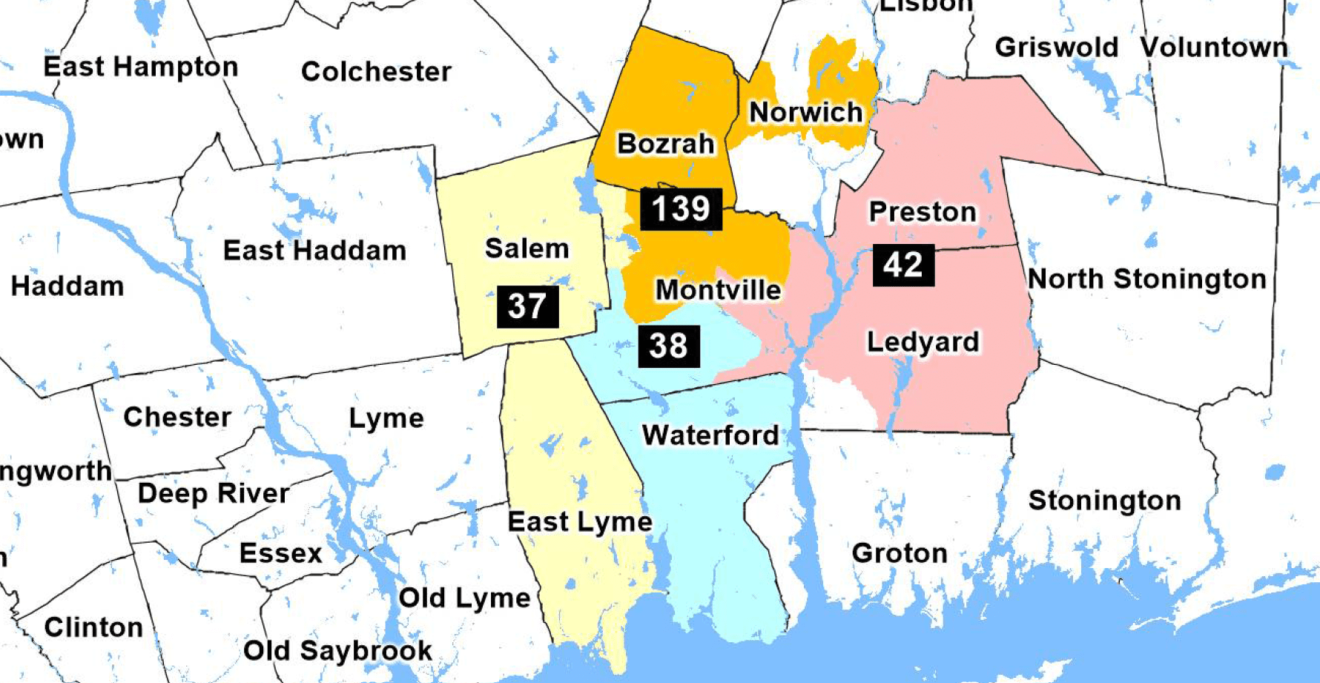As Connecticut’s electoral maps are redrawn this year — new legislation could change the way that prisoners are counted, shifting local district lines and funding between rural and urban districts.
State Sen. Gary Winfield, D-New Haven, has proposed a bill that would count prisoners in their last district of residence rather than in the district where the prisons are located.
Winfield told CT Examiner in February that, because prisoners don’t have the right to vote, the representatives in the districts where the prisons are located generally don’t support policies that benefit the prisoners. Nor do the prisoners take part in the daily life of the region, or benefit from the services in that area.
“They don’t drive on those streets, they don’t send their kids to those schools, they don’t shop in their stores,” said State Rep. Christine Palm, D-Chester.
If passed by the legislature, the change would take effect this year, as the districts are redrawn using the data collected during the 2020 census. It’s a process that happens only once every 10 years.
A constitutional Issue
Supporters of the bill argue that the current system in Connecticut of including individuals in districts where they are incarcerated, but cannot vote, gives voters in those districts an inequitable share of power.
In 2018, the Connecticut chapter of the NAACP filed a lawsuit against the state alleging that Connecticut was violating the “one person, one vote” requirement written in the U.S. Constitution.
Alex Boudreau, a student intern at the Yale Law School’s Peter Gruber Rule of Law Clinic, which represented the NAACP in the lawsuit, said that the legal efforts were met with favorable rulings in both state and appeals courts before the pandemic brought the process to a halt.
But Boudreau said that the legislature offered a much more direct process than going through the courts, and provided a greater amount of certainty.
Ten other states, including New York, New Jersey and Maryland, have adopted similar legislation.
In addition to granting greater voting power to the districts where the prisons are located, the bill’s proponents argue that it also dilutes the power of the districts that the prisoners consider home by removing these prisoners from the count in that district. Many of these home districts are urban areas with a large minority population.

State Rep. Quentin Phipps, D-Middletown, said this could mean a loss of funding in the prisoner’s district of residence, where the prisoners often have relatives.
“We have members of our community that are entitled to resources and support and assistance and care, and those resources will not follow them,” said Phipps.
He gave the example of funding through the Educational Cost Sharing Formula, which uses population to determine the wealth of the municipality and the amount of funding it should receive.
In written public hearing testimony, State Sen. Martin Looney, D-New Haven, pointed out that several state funding formulas rely on census-based population counts, including Payment in Lieu of Taxes.
The lawsuit echoes this.
“Entire communities lose their voice in state affairs when fathers, sons, daughters, and mothers are shipped to remote, rural prisons,” the plaintiffs argued in the lawsuit.
An issue of race
Phipps said the problem is not only one of justice, but also of racial equity.
“I think it’s time to call it what it is, which is racial gerrymandering,” he said. “Until our prison population is more diverse, I think we have to look more honestly about how we are using black and brown bodies to run up residency numbers.”
Based on 2010 census data, the four towns that prisoners most often named as their places of residence were Hartford, New Haven, Bridgeport and Waterbury — cities with a large number of minority residents. And twenty-seven percent of the prison population is white, 28 percent is Latino and 44 percent are Black, according to data from the Department of Corrections.

But many of the prisons are located in rural areas with a majority white population — providing a boost in local population numbers, without the burden of providing additional services.
Somers houses 902 prisoners in Osborn Correctional Institution. Enfield houses a total of 1,172 prisoners in Robinson, Northern and Willard-Cybulski Correctional Institutes, and Cheshire houses 995 prisoners in Cheshire Correctional Institution and 257 prisoners at Manson Youth Institute. Macdougall-Walker Correctional Institute in Suffield is home to 1,157 prisoners.
Corrie Betts, Criminal Justice Chair of the Connecticut NAACP, said in his written testimony in a public hearing on the bill that he considered this an “injustice” that the General Assembly has “a moral imperative” to correct.
“Prison gerrymandering not only harms incarcerated people themselves, who are predominantly Black and Latinx, but also harms Black and Latinx communities in the state for the benefit of less diverse areas,” Betts wrote in his testimony.
Redistricting
As written, the bill would require the Department of Corrections to provide the Office of Policy Management with a prisoner’s name, place of incarceration and last address prior to being incarcerated. The Secretary of the Office of Policy Management would be responsible for making sure the incarcerated individual was counted in the geographic district where they lived before being incarcerated.
Rep. Holly Cheeseman, R-East Lyme, said that, depending on the change in population of the surrounding towns over the last decade, the addition or removal of prisoners from the count could shift the borders, not only of the district where the prison is located, but also the surrounding districts, through a kind of ripple effect.
“Once you start tinkering with one, you have to adjust all the others,” said Cheeseman, whose district includes York Correctional Institute, which houses 502 prisoners.
Secretary of the State Denise Merrill said in a public hearing that determining an individual’s last place of residence could be challenging, and that there would need to be conversations around how to determine that. However, she said she believed the change would give more accurate and fairer representation in the districts.

State Rep. Gregory Haddad, D-Mansfield, pointed out that prisoners who are allowed to vote, mainly pre-trial individuals, vote in their districts of residence.
Cheeseman said she understood the argument for changing how the prisoners are counted, but thought it was important to consider how long the individual had been incarcerated in a particular area.
State Sen. Robert Sampson, R-Meriden, questioned how a prisoner with a life sentence or a residence out of state should be counted.
“You start asking many, many questions, and it leads to even more,” said Sampson.
A once-in-a-decade count
Boudreau said he thinks the bill has a strong chance of being passed. He said that the bill has support from a variety of groups, including the unions, faith leaders and the American Civil Liberties Union. He also added that there is a sense of urgency that didn’t previously exist, because of the redistricting timeline.
“They have to do it this session, or the new maps will entrench this into law [for] the next ten years,” he said.
Phipps, who put forward a similar bill during the 2019 legislative session, agrees that there is more support this year.
“I’m confident it will pass,” he said. “I think we’ve all understood that using black and brown bodies to benefit other communities is immoral and wrong.”
The spelling of the name Alex Boudreau and the date of the lawsuit have been corrected in this story

